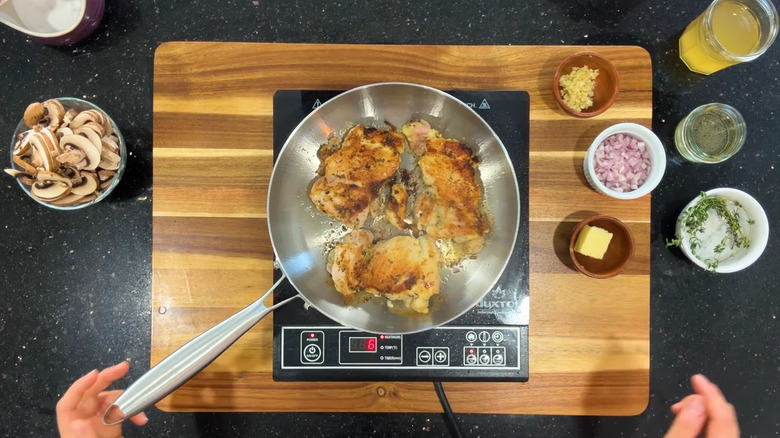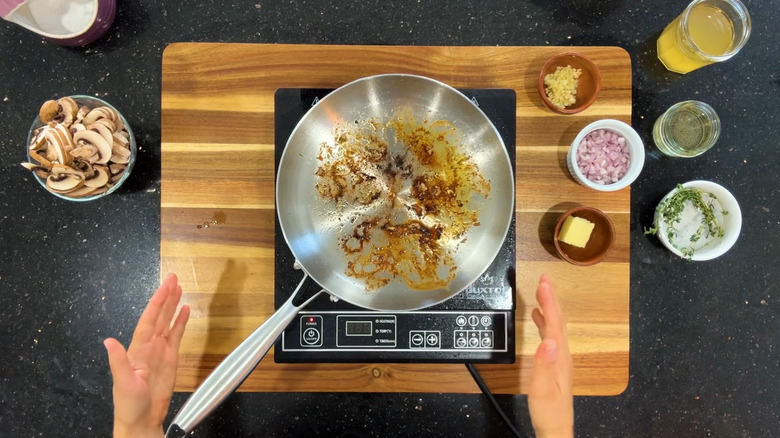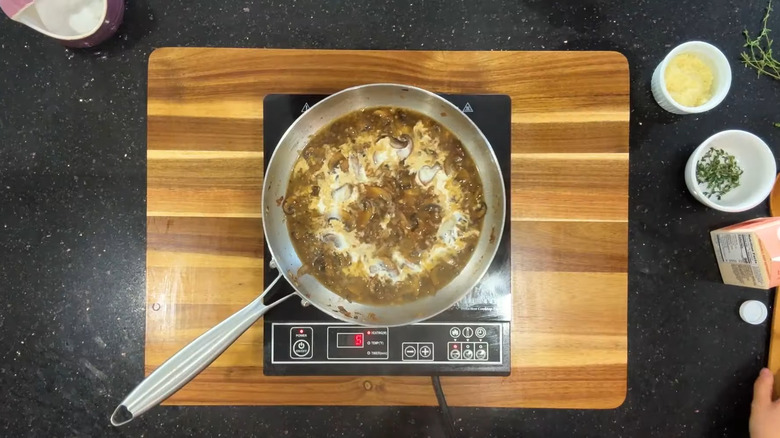Here's Exactly What You're Doing Wrong When Deglazing A Pan
We have all been there. Facing the aftermath of a delicious, homemade meal that is waiting in the kitchen is a universal experience, really. Worse than putting away all of the ingredients and placing the now-empty plates into the sink is thinking, "how in the world am I going to deglaze that pan?" The culprit sits on the stove, in its dirty glory. While there are many pantry staples that are great for cleaning that would be up for the task, there is a better, more flavorful way to leave a pan spotless after cooking.
In a Chowhound YouTube video that's part of a "You're Doing It All Wrong" series, Chowhound recipe developer Katie Rosenhouse shows us that better way. She explains that cooking a pan sauce will deglaze the vessel while capturing all of the flavor of the fond and fat gathered at the bottom.
While preparing a pan sauce to go with a chicken dish, Rosenhouse points out how using a nonstick pan, not harnessing the fond and fat, and not stirring the pan sauce as it cooks are the main mistakes that can occur in this deglazing process.
Whatever you do, make sure it sticks
Katie Rosenhouse suggests that abandoning your beloved non-stick pan is the first step to achieve an easy pan deglazing. While eschewing a non-stick pan is a common mistake you are probably making with pancakes and other foods, using a non-stick pan is a mistake when deploying Rosenhouse's method for deglazing a pan. Rosenhouse explains that when a non-stick is used, "It's just not going to let those bits really adhere properly and you're not going to get as complex a flavor when you finish cooking." Stainless steel pans are especially good for this method of deglazing.
Rosenhouse emphasizes that there is no need to worry about ingredients sticking to the pan. That's because, if the surface is hot enough before the main protein is placed inside, that protein will release once it is caramelized. As the meat cooks, fats, sugars, and proteins gather at the bottom of the pan, becoming little brown bits of flavor — known as the fond — that will be captured with a pan sauce.
Let no flavor go to waste
The biggest mistake you may make when deglazing a plan is taking your pan straight to the sink and scrubbing away. Katie Rosenhouse explains that the fond and fat that gather in the pan after protein or onions are cooked are packed with flavor. Washing it down the drain would be a shame, while the most efficient and opportunistic way to get these brown bits off the bottom of the pan is to use them to create a sauce.
For a more flavorful sauce, use aromatics such as garlic or butter early on. Both provide a richer flavor and should be cooked and stirred with the pan glaze. The fond is likely to continue browning during this process, though liquid from some of the aromatics may slow down this process so should not burn — though keeping an eye on things is a good idea here.
As the aromatics of your choice cook, Rosenhouse recommends using a wooden spoon, a great alternative to possibly toxic black plastic cooking utensils. Use the spoon to stir up some of the brown bits from the bottom of the pan. After the first ingredients are seasoned and cooked, it is time to add a liquid for the sauce.
Don't stop stirring the sauce
Katie Rosenhouse advises that your pan sauce not be left to simmer after the liquid of your choice is added. The key is to keep stirring the ingredients and scrape the bottom of the pan to both incorporate the flavor of the glaze and clean your pan during cooking. Once the liquid is added, Rosenhouse also says to let the mixture reduce in order to create a sauce with the perfect flavor and thickened texture.
Rosenhouse emphasizes that the liquid you add as the body of the pan sauce — whether it is broth, beer, wine, or even water — is entirely up to the cook, and all will help deglaze the pan in the cooking process. "When you're deglazing, the type of liquid can totally vary based on what the dish is, what you're interested in, what compliments the flavors that are already in the dish," Rosenhouse explains. Late in the process, a touch of cream can even be poured in as the sauce simmers to add some richness, help the sauce thicken, and to lighten the color of the sauce.
Static Media owns and operates Foodie and Chowhound.


